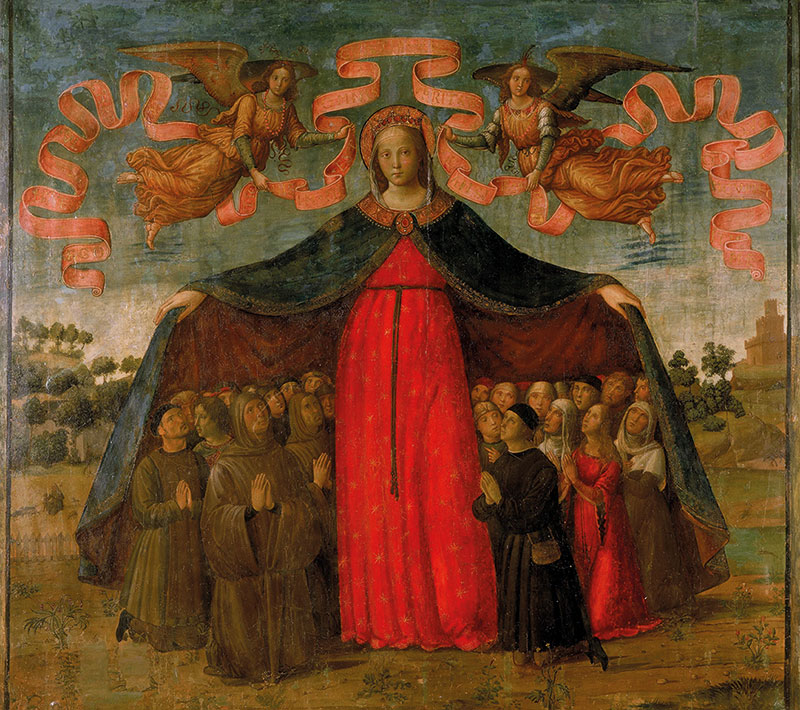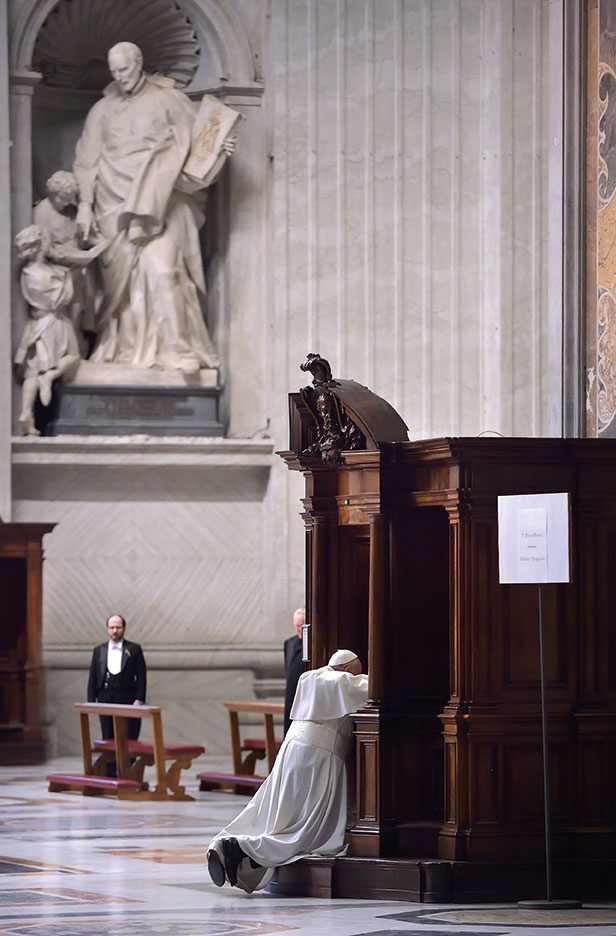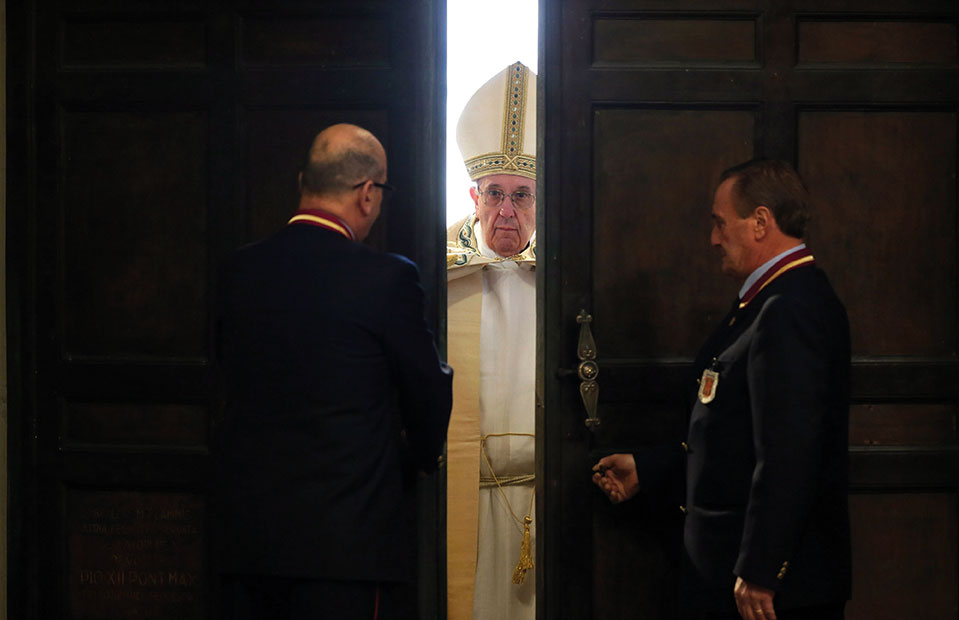I would like to dwell on these words with which the Holy Father has pointed out the essential link between Mercy and the life of the Church: "Mercy is the main beam that supports the life of the Church." (n. 10 of the Bull of Convocation of the Holy Year).
The main beam is an absolutely "essential" element in any building, together with other architectural elements, without which it would have no reason to exist.
First of all, it presupposes by itself the existence of a building, and invites us to consider the Church, which we confess as Catholic and Apostolic, and therefore missionary and structurally "going forth", also in its dimensions of Unity and Holiness: it appears as the "...".Domus aurea"The golden house, the spiritual building, in whose construction we are used as living stones (cf. 1Pt 2:5), and whose only foundation is Christ himself (cf. 1Cor 3:11).
We will be able to dwell attentively on the structure of the main beam to the extent that we are interested in crossing the threshold of this building and inhabiting it as our definitive House. This is the Temple destroyed by men and rebuilt on the third day (Jn 2:19), not made by human hands. It was opened to us in Baptism, through the work of the Holy Spirit. In this House, human existence attains and embraces its proper meaning in an integral way, presenting on the altar that oblatio rationabilisThe spiritual worship, which offers, in union with Christ the Lord, the living sacrifice, holy and pleasing to God (cf. Romans 1:1). 12,1).

From this "Domus aurea"In this spiritual and historical edifice which is the Church, Christ himself is the Door, the Way. In him, life is continually illumined by the light of "Christ-Truth," which enters freely and illumines everything through the uninterrupted teaching of the Apostles and their successors, in communion with Peter. In its interior, the Life of Christ is communicated to the multitude of the brethren, reborn from the one source, the bosom of Holy Mother Church. They are inhabitants of the Domusbut also living stones used in the construction of the Building. This Life is communicated in an eminent way in the banquet and in the Eucharistic-sacramental sacrifice, a real pledge of the eschatological one, which unites all and raises them to the presence of the Father, by virtue of the one Cross of Christ.
It is therefore one Church, the Church that Christ, Crucified and Risen, has generated and has generated for more than two thousand years; the place of the true, new and eternal life that we have received, of the saving communion with the Son of God made Man; a saving communion that represents the only and true goal of the whole mission of the Church.
Looking at the reality of the Church in the theological-sacramental perspective, let us consider the richness of the image used by the Holy Father in a threefold perspective.
Visibility and splendor
In the first place, the main beam is presented as a structural architectural element, essential for the whole building and each of its parts. With the limits proper to any analogy, we can affirm that mercy is, and has always been, well "visible" as a main beam throughout the history of the Church.
Abandoning the metaphor, there has never been a time when the Church has not proclaimed with conviction the Gospel of mercy, since the day of Pentecost, when St. Peter, leaving the cenacle, responded to the crowd that with pierced hearts asked what they should do: "Repent and be baptized every one of you in the name of Jesus, the Messiah, for the forgiveness of your sins, and you will receive the gift of the Holy Spirit. For the promise is to you and to your children, and to those who are afar off, as many as the Lord our God shall call to himself." (Acts 2:38-39).
Now this proclamation of divine mercy, unlike the master beams of this world, decorated to please the observer, has no need of ornaments, because it has in itself all its splendor. As the Apostle affirms: "I myself, brethren, when I came to you to proclaim to you the mystery of God, I did it not with sublime eloquence or wisdom, for I never boasted among you that I knew anything but Jesus Christ, this crucified One." (1Cor 2,1-2).
If it is true that the Church has had to face several times over the centuries the perennial temptation of man to save himself autonomously, she has always responded, defended and reaffirmed before everyone the absolute gratuitousness of Mercy, which certainly requires sincere repentance, but remains infinitely greater than any human ugliness.
Thus, the Church, to the Donatism of the fourth century, which wanted the exclusion of the lapsi of communion, he responded with the readmission of repentant brothers and with the fundamental doctrinal truth of the ex opere operato. To the Pelagianism of the 5th century, it responded with the Augustinian deepening of the doctrine of Grace. To the Cathar-Albigensian heresy of the twelfth and thirteenth centuries, it responded, in the preaching of the mendicant orders, with the goodness and unity of creation, integrally assumed and saved by Christ.

To the Lutheranism of the 16th century, he responded by reaffirming the real efficacy of justification by grace, the truth of the Sacraments - especially those of the Eucharist and Reconciliation and, by obvious consequence, that of Holy Orders - and the goodness and sufficiency of attrition to obtain the forgiveness of sins. In addition, by extraordinary heavenly blessing, the Domus Aurea The most beautiful fruits of that time could be seen in the lay saints, religious, mystics, pastors and missionaries of that time: just think, for example, of St. Philip Neri, St. Ignatius of Loyola, St. Charles Borromeo, St. Francis de Sales, St. Camillus de Lelis, St. Teresa of Jesus... and the list could become a dictionary!
In the seventeenth and eighteenth centuries, the Church responded to Jansenist legalism and rigorism with the moral doctrine of the preventive, simultaneous and successive action of grace, which has its most precious fruits in St. Alphonsus Liguori and in the holy shepherds of the twentieth century. To the modernism of the last century, which claimed to elevate itself to be the only real interpreter of man, it responded with the texts of the Second Vatican Ecumenical Council, which reaffirmed Christ-God as the only real fullness of every man and the Church as a divine and human reality at the same time, in its irreducible sacramental, liturgical and missionary dimensions.
To the dictatorship of philosophical and religious relativism of contemporary times, the Church responds by reaffirming the universal salvific uniqueness of Christ and His cosmic Truth, in which history, the whole of creation, the nature and dignity of man and, finally, his irreducible freedom before the offer of salvation are inscribed.
It would be short-sighted, therefore, to try to anchor the proclamation of God's love and mercy in the most recent epoch of the Church (perhaps in the last fifty years), contrasting it perhaps with ghostly long centuries of "clerical terror" in which too much was said about the Judgment of God and the punishments of hell. Certainly, we must always avoid any dangerous unilateralism; moreover, in order to correct any exaggerations, we cannot resort to other exaggerations. I believe that a real attention also in preaching to the divine prerogatives of Omnipotence and Judgment can only help the proclamation of Mercy. It is much more interesting, in fact, the free choice of love and mercy that God makes in His Omnipotence, than the idea of a God "obliged" to be merciful, without always choosing it, in the face of every man, every circumstance, every concrete sin.
Budget and structure
Once we have identified the main beam of Mercy as a clearly visible architectural element in the building of the Church, we can analyze its presuppositions and its function. Let us speak first of the presuppositions, because every main beam is not, at the architectural level, "of thrust" but "of support". It is a horizontal element, which supports an upper part, but unloads its weight on two vertical arms also distributing the weight of the upper structures. What are the two presuppositions, the two "supporting columns" of the architrave of mercy? What are the supports without which it could not be supported? Many may be astonished, but we must first of all affirm that, theologically speaking, "mercy" is not an "original" attribute of God.
Let me explain. With St. John the Apostle, we must confess first of all that "Deus Caritas est - God is Love. We can and must affirm that God, by sending His Son made Man in Jesus of Nazareth, Lord and Christ, dead and risen, has made us know that He is, in Himself, Love: Love of the Three Persons. Such intra-Trinitarian Love, however, cannot be configured in Himself as mercy, because it knows no "ontological hierarchy" among the Three Divine Persons, who are equal in the one and same Nature. The idea that the Father should "have mercy" on the Logos or the Holy Spirit would not be at all acceptable!
When, then, can we begin to affirm, with the Psalm, that "his mercy endures forever".(Ps 135). When God creates.
When God creates the spiritual and the material cosmos and, above all, when He creates man, He participates at the same time in one and the other. God, who is a communion of Persons, in Himself in relation with Another distinct from Himself, can also create, conceive something that is "totally other" from Himself. Creating the intelligent and free human person, He loves outside of Himself. He loves the free man, and calls man to love. This Love of God, addressed to us and recognized by us, is, on a level that we could call creatural, "mercy". Love absolutely gratuitous because it is divinely free, which rests on what is "wretched" because it is infinitely far from divine perfection.
Mercy, therefore, has as its double presupposition the divine freedom that creates and the very existence of created man. By the will of God, it is irrevocable, so much so that not even in eternal damnation, which man inflicts on himself by his sin and final impenitence, does God deprive condemned souls of the merciful gift of being and existence. The Most Holy Trinity, Blessed and Perfect in Itself, has willed to bind human existence to Itself forever, and we, then, will truly be able to sing with the angels: "The Holy Trinity, Blessed and Perfect in Itself, has willed to bind human existence to Itself forever."eternal is his mercy"!
The image I have adopted presents, on this point, all its limits, because the uncreated and eternal freedom of God and the created and temporal freedom of man cannot be conceived in an equal way, and are not ontologically coessential. Divine freedom is subsistent in the absolute sense and is not in need of anything; man's freedom, on the other hand, is created and depends essentially on divine freedom, and is indispensable for the mystery of mercy only because God wants it by creating it.
But there is a further level of mercy, which not only brings man into existence, but also enters into relationship with created man. Man, in fact, even though he is made by God and for God, decides to sin, that is, to direct his freedom against the Creator, thus staining himself with an infinitely grave guilt, from which he will not be able to recover with his poor strength.
It is here then that, by divine Will, the new and great initiative of Eternal Love is developed within the space of creation: "In the sixth month the angel Gabriel was sent from God to a city of Galilee called Nazareth, to a virgin betrothed to a man whose name was Joseph, of the house of David; the virgin's name was Mary." (Lk 1:26-27). After having formed the people of Israel, after having revealed the Law to them and thus having shown them their sin, God turns to Mary to save us.
From the encounter between uncreated divine freedom and the created and immaculate freedom of Mary Most Holy, who welcomes the angel's Annunciation, a new and definitive mercy arises: the Incarnation of the Word. The Son of the Eternal Father takes our flesh in her and thus binds himself in a new and indissoluble way to human nature and, in the mystery of his Incarnation, Death and Resurrection, becomes forever "the" mercy. In Christ the divine intimacy is definitively opened to us: he sacrifices himself on the Cross for our sin, offers us salvation and makes us personally sharers in his own life.
The Church, the universal sacrament of salvation and minister of mercy, is built on the divine mercy of the divine-human Heart of Christ, inasmuch as it is a continuation, in space and time, of the living presence and saving work of Christ.
Then, within the life of the Church, through the apostolic ministry, which participates in the one, eternal and supreme Priesthood of Christ, the main beam of mercy, in a certain sense, is "prolonged" as, by the grace of vocation, a man's created freedom responds to the gift of Christ's call and offers himself to his service, in the fascinating adventure of the ministerial Priesthood. The whole Church is then as it were "woven" of this mercy, and on it she develops her whole life. The Petrine ministry itself is born of the mercy of Christ, who, after the triple profession of love that followed the triple betrayal, entrusts his own flock to Peter: "Yours." -St. John Paul II has repeated to us. "it is a ministry of mercy born out of an act of mercy of Christ". (Ut Unum Sint, n. 93).
Irreplaceable and essential function
It remains for us to delineate the function of the architrave. Sustained by the mystery of divine freedom and the response of human freedom that welcomes salvation, mercy in turn sustains the whole life of the Church; one could say that it is "at the beginning" of the Church's life, in a double sense.
First of all, the life of the Church develops by an ever new act of the mercy of Christ who, through the ecclesial ministry, consecrates the baptized and communicates his very life to them. Secondly, such a principle does not consist in a "chronological beginning" that can later be left behind, but in an "ontological principle": the life of the Church is sustained and guided by the grace of Christ, welcomed in listening to Apostolic teaching and prayer, nourished and perfected by the Most Holy Eucharist, restored and strengthened by sacramental reconciliation.
Considering precisely Reconciliation, we see how mercy can "happen" sacramentally only in the encounter between two co-involved freedoms: the divine and the human. Divine freedom is given, definitive, irrevocable, and every time a minister is willing to offer it, it becomes sacramentally accessible. Human freedom, on the other hand, is expressed in repentance, in the pain of the sin committed together with the resolution not to commit it again in the future, and in the accusation that opens the heart of the sinner to the saving truth of Christ. In the time of this pilgrimage, human freedom always preserves the power tremendum to accept the mystery of divine mercy and allow oneself to be inwardly renewed by it, or to reject it, thus showing how the very Omnipotence of God loves above all else precisely our freedom, to the point of pouring into it all the riches of His Heart as soon as it makes a gesture of opening up; and He respects the human choice that tragically decides not to let itself be loved or, what is the same thing, does not decide at all. God never does violence to anyone!
The mercy that works in sacramental Confession will only liberate and spread the grace of the sacrament of Baptism, the first source and perennial principle of the mercy that builds up the Church.
I believe that only this integral realism in relation to divine mercy will be able to awaken and sustain the long-awaited new evangelization, announcing without fear or complexes the truth of Christ the Savior. Today it is more necessary than ever to "provoke" the freedom of man, who will finally find himself before the most unprecedented and great fact of history: God made man, dead and risen, who lives in our midst.
In this work of evangelization, may the Immaculate Virgin Mary, perfect work and most pure reflection of divine mercy, sustain us! ante praevisa merita! May she teach us the total and ever new availability to the will of Christ; thus the truth that Mary Most Holy contemplates in the blessed eternity will always appear more and more in the eyes of our hearts: God, in creation and redemption, is mercy, is all mercy, is only mercy! n
Major Penitentiary









